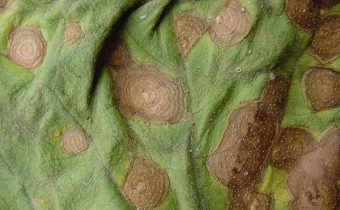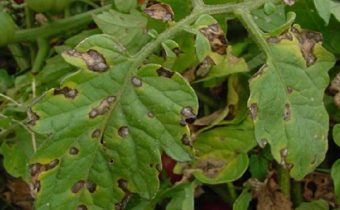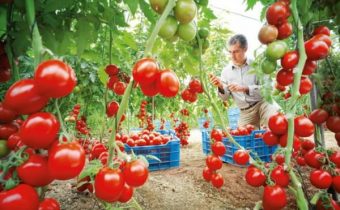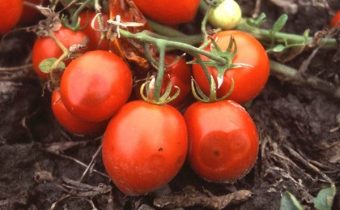How easy it is to remove leaf mold on tomatoes in a greenhouse
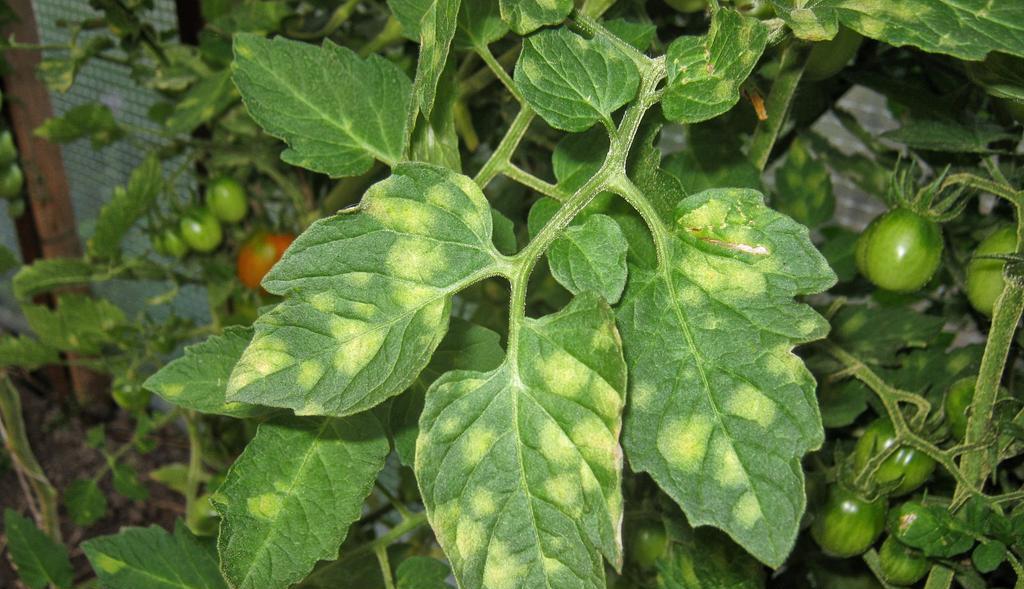
Leaf mold or, as it is also called, brown spotting, known to agronomists as cladosporia, in the overwhelming majority of cases affects tomatoes growing in the greenhouse. Even in situations of prolonged rainy periods, plants in the open field are usually protected with insufficient temperatures to activate the causative agent of the disease in such weather.
Indoors, where conditions can be perfect, the disease can not only reduce the volume of the crop, but also lead to the destruction of the bushes.
Causes of leaf mold
The disease causes the fungus Cladosporium fulvum Cooke. In the sleeping state (conidia), the fungus can retain the ability to develop for almost a year, without losing it either as a result of exposure to low temperatures, or after a long stay in a dry environment. The pathogen overwinters safely in the ground, even if the garden bed is cleared of plant residues, and returns to tomatoes next season.
Conidia of the fungus infect the soil to a depth of no more than 10 cm, so in case of illness, after harvesting, it is recommended to replace this layer of soil in the greenhouse.
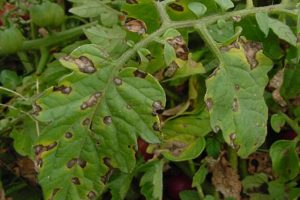
Fungi can penetrate into the closed ground with water, air, work tools and clothing. Once in a favorable environment, the conidia of the fungus that fell on the plants, including weeds, begin to germinate.
Humidity is critical for the causosporus pathogen. To activate conidia, this indicator should be above 80% (the optimal level is 90-95%). At a suitable temperature (within + 22 ... + 25 ° C), the fungus begins to spread rapidly through the planting of tomatoes.
As a rule, the fungus infects weakened plants, and often the trigger for the disease of tomatoes in the greenhouse becomes the stress experienced by them due to a sharp jump in temperature (with improper ventilation, watering with cold water).
Symptoms of Cladosporiosis
Signs of the disease in tomatoes often become noticeable gardener at the stage of flowering and formation of ovaries. The very first symptom - light green spots on the leaves - appears during the budding period. Gradually, the spots become yellow in color, starting to stand out against a green background; a gray patina forms on the back of the sheet in the corresponding areas. Over time, the plaque becomes more dense, velvety to the touch, its color changes in the direction of brown-brown shade.
Affected leaves become deformed, turn yellow and dry out. The plant, losing its leaf cover, weakens and languishes due to the disruption of the processes of photosynthesis and, accordingly, the nutrition of its cells. Even if the sick bush does not die, it will not be able to grow a full-fledged crop - the fruits will be small, although suitable for food. Usually, the fungus affects only the leaves, but can spread to flowers and ovaries.
Leaf mold treatment
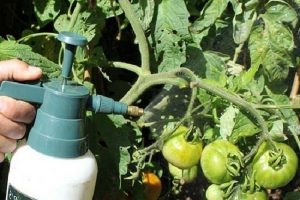
Cladosporiosis is one of those diseases in which it is critically important to begin treatment as early as possible. If it is possible to detect a lesion and take action at a stage when the spots on the leaves are just beginning to acquire a yellowish color, the crop is usually preserved without loss.
Chemicals
Processing fungicides - the most reliable means of combating the brown spot of tomatoes.In the later stages of the development of the disease, only chemicals can save the crop and the plants themselves. Processing is allowed to be carried out no later than 3 weeks prior to the removal of fruits from the bushes.
It is recommended to use drugs against leaf mold:
| A drug | Volume of substance per 10 liters of water | Consumption of the finished solution per 1 hectare |
| "Poliram" | 41 g | 6 l |
| "Abiga Peak" | 50 g | 10 l |
| "Cineb" | 40 g | 6-8 l |
| "Kvadris" | 6 ml | 10 l |
| "Bravo" | 60 ml | 4-6 l |
| "Polyhom" | 30 g | 10 l |
| "HOM" | 40 g | 10l |
Spraying should be repeated after 10-15 days.
Folk remedies
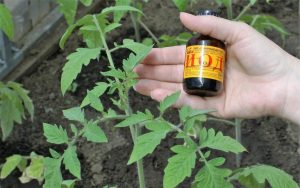
In the early stages of the development of the disease, the use of folk remedies may be sufficient to suppress the activity of the fungus, although there is a risk that the treatment will not help. Folk remedies can make an effective prevention of leaf mold for plants in greenhouses, where fungus appeared in past seasons.
- Iodine. To prepare the solution, add 40 drops of iodine to a bucket of water and mix. With iodine solution you can not only spray the bushes, but also water the soil. The liquid should penetrate to a depth of at least 10 cm.
A popular recipe with iodine and potassium chloride for irrigation of tomatoes affected by cladosporia should not be used, because the culture does not tolerate chlorine. But the tool can be used for autumn soil treatment against the fungus, provided that the shelter is removed for the winter (chlorine is faster than the potassium is washed away by precipitation, therefore potassium chloride in this case will act as a fertilizer). To prepare the agent, 10 g of potassium chloride should be added to 10 liters of iodine solution.
- Milk products. Both normal and sour milk are suitable for spraying, whey is most effective against brown spot. 1 part of the product must be diluted with 10 liters of water. To enhance the effect of milk, add 30 drops of iodine to the solution.
- Potassium permanganate. Bushes spray and water the soil of the garden with a light pink solution of potassium permanganate.
- Ash. 300 g of ash must be boiled in 3 liters of water for 20 minutes, then add 7 liters of water and leave to infuse for 3 days. Means it is possible to water soil and spray bushes. It is recommended to add some soap to the spraying liquid (this solution is better kept on the leaves and stalks of the plants). Watering with the ash solution is maximally effective if you alternate them with watering with potassium permanganate (irrigation is performed once every 7 days, each of the products is used once every 2 weeks).
Agrotechnology
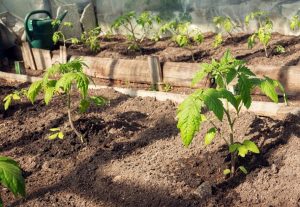
If the disease manifested itself during fruit ripening, when treatment with chemical fungicides is not recommended, it remains to stop it, stopping the activity of fungi by creating unfavorable conditions for them. Influencing the fungus with the help of agrotechnical techniques is worth it and in parallel with any treatments of the bushes, this will increase the chances of success of the treatment.
Effective activities:
- Reduce air humidity to 60-65%. Humidity below 70% inhibits the development of a colony of fungi on plants, while tomatoes are comfortable in such conditions.
- Increase the temperature in the greenhouse above 25 ° C. But not more than 30 ° C, otherwise it will affect the quality of formation of ovaries in tomatoes and the taste of fruits.
- Stop at the time of watering. It will also stop the spread of the fungus.
- Fight weeds. The fungus is able to develop on weeds, sweating on tomatoes.
- Remove affected leaves. Since conidia are very light, when the leaf is torn off, they are scattered in the air, settling on other parts of the plant. In order not to promote the spread of the fungus, you must first place the diseased leaf in a plastic bag and carefully cut off the bush with a knife. All removed biomaterial (diseased leaves, weeds) must be burned.
Disease prevention
Measures to prevent leaf mold should be divided into 2 groups: prevention of the first appearance and prevention of the return of the disease.
Measures from the first group are common to prevent the occurrence of fungal diseases and a number of pests in the greenhouse:
- After harvesting, you must immediately remove the tops, weeds, the remaining fruits and other plant debris from the beds.
- In the fall, it is necessary to carry out deep soil digging. It is advisable to repeat the procedure in the spring.
- Planting seedlings in a greenhouse, keeping a distance of 30 cm between the bushes. When planting is thick, the disease spreads faster from one plant to another.
- Regularly aerate the greenhouse, preventing excessive increases in humidity.
Reducing the humidity in the greenhouse will help mulching landings with peat.
- Do not allow excess moisture in the soil, controlling watering.
If the fungus is already marked on the tomatoes in the greenhouse, regardless of the success of the treatment undertaken, care should be taken to protect the greenhouse and planting in it from cladosporia in the new season. It is rarely possible to completely remove the fungus from the first time, but with the right exposure, it is possible to at least suppress the awakening of the conidia.
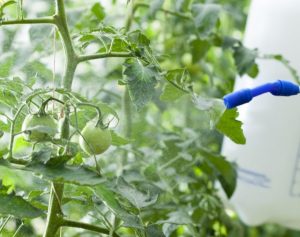
In this case it is necessary:
- Disinfect the greenhouse. One of the favorite wintering places of the fungus is a wooden frame shelter. Formalin treatment (200 cm3 of 40% substance per bucket of water) and fumigation with sulfur (40-50 g per 1m3) will be effective.
- Perform presowing seed treatment. To combat the leaf mold is suitable "Thiram" or "Fentiuram."
- Treat tomatoes with a solution of copper oxychloride (0.4%) or Bordeaux mixture (1%) during the active growing season. Then every 10-15 days spraying infusion of garlic or antibiotic "Trichopol" (1 tablet per liter of water).
- Water the tomatoes at the beginning of the growing season with a solution of the drug Metronidazole (dissolve 15 tablets in 1 liter of water).
- To spend for the season 3 processing tomatoes with the antimicrobial agent Furacilin (1 tablet per 1 liter).
- Well opposed to disease drugs containing bacteria that feed on fungi. During the entire growing season, including the fruiting season, it is worth treating the planting (keeping up with the breaks indicated in the instructions) with Fitosporin-M, Fitovlavin 300, Pseudobacterin-2 and Integral.
In the event that the fungus cannot be defeated, it remains to select a variety of tomatoes for cultivation that are not susceptible to or exhibit high resistance to the disease:
- Admiralty;
- Gardener;
- Black moor;
- Delicacy;
- Paradisaic delight;
- Giant;
- Red Arrow;
- Cherry red.
Among hybrids can be found more resistant to cladosporiosis:
- Our Masha;
- Favorite;
- Pink Paradise;
- Energy;
- Titanic;
- Centaur;
- Kostroma;
- Torbay;
- Red Comet;
- Prime minister;
- Funtik;
- Victoria;
- Margarita;
- Torbay;
- Flamingo;
- Vitador;
- Malika;
- Eupator;
- Octopus;
- Donna Rosa;
- North Express;
- Business woman.
The fungus that causes leaf mold with great difficulty removed from the greenhouse and can remind myself even after a few years. Therefore, in case of occurrence of the disease it is recommended to switch to the cultivation of resistant varieties. Also, do not forget about the disinfection of clothing and garden tools, so as not to spread the disease to plants in other greenhouses.


 (2 ratings, average: 4,50 from 5)
(2 ratings, average: 4,50 from 5)